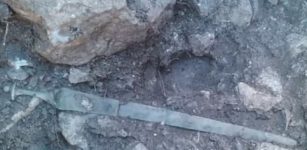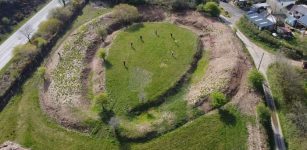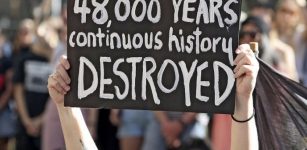Ancient Mystery Of The Leo Petroglyphs In Ohio Created By An Unknown Native American Culture
Jan Bartek - AncientPages.com - Perched on a ridge near the small village of Leo in Jackson County, Ohio there are curious ancient petroglyphs that remain an unsolved ancient mystery.
The sandstone petroglyphs containing 37 images of humans, birds, animal, and human footprints, a fish, a snake, and other figures are a legacy of an unknown Native American culture. When scientists examined this ancient art, they realized there were two questions they could not answer.
Sandstone petroglyph near the village of Leo, Jackson County, Ohio. Image source
For one thing, researchers have been unable to identify the creators of these remarkable carvings. Another problem is the fact scientists cannot determine the meaning of these images. Were the petroglyphs deliberately made to depict daily life or do these carvings have a symbolic meaning?
The exact age of the petroglyphs found on the edge of an unglaciated Mississippian sandstone cliff 20–65 feet high remains undetermined, but it’s believed the carvings are about 1,000-year-old.
It has been suggested the carvings were made by the Fort Ancient culture, 1000 to 1650 A.D. that thrived in the areas of modern-day southern Ohio, northern Kentucky, southeastern Indiana, and western West Virginia. There is not much information about the Fort Ancient culture but is known these people were primarily farmers and hunters who lived in villages that had many circular or rectangular houses surrounding an open plaza.
View of the The Great Serpent Mound, one of the most important prehistoric effigy mound of Adema Culture, located on the Ohio river, Ohio, USA. Credit: Timothy A. Price and Nichole I - CC BY-SA 3.0
To begin with, they buried their dead in small burial mounds, but later their burial traditions changed, and they put to rest the deceased in a cemetery with no burial mounds. The Fort Ancient culture is perhaps most famous for the creation of the magnificent and great Serpent Mound of Ohio that is one of the most famous ancient earthworks of Most Famous North America.
Though other serpent mounds can be found in Mexico, Scotland, and Canada, Ohio's serpent mound is by far the largest and most interesting serpent mound in the world. One must add there is no conclusive evidence the Serpent Mound is a legacy of the Fort Ancient culture, but most scientists think these people were in fact the creators of this impressive ancient earthwork.
What are these images supposed to represent? Image source
This assumption has also led many to speculatee the Leo petroglyphs in Ohio were also made by the Fort Ancient culture, but we do not know this was the case with certainty.
Some of the Leo Petroglyphs suggest creators of these carvings were in contact with Europeans. This is interesting because although there are no historical records of contact between the Fort Ancient culture and the Europeans scientists have discovered a remarkable amount of European made goods from Fort Ancient sites, including brass and steel items, as well as glassware. The Fort Ancients were heavily affected by European disease, as well as the Beaver Wars period. This Native American culture vanished, but gradually.
Leo Petroglyph, face with headdress. Image source
Some of the mysterious Leo petroglyphs are exceedingly difficult to understand. Whoever did these carvings must have wanted to tell future generations something. Unless the petroglyphs were just produced as entertainment of course. What could be the meaning and purpose of some of these more abstract designs, including one that looks like a cartoon man with horns?
Written by Jan Bartek - AncientPages.com Staff Writer
Updated on July 20, 2024
Copyright © AncientPages.com All rights reserved. This material may not be published, broadcast, rewritten or redistributed in whole or part without the express written permission of AncientPages.com
Expand for referencesMore From Ancient Pages
-
 Mystery Of The Ancient Talayot Sword
Archaeology | Sep 30, 2019
Mystery Of The Ancient Talayot Sword
Archaeology | Sep 30, 2019 -
 Huge Ancient Underground Stone Circle Discovered Inside Cornwall Neolithic Henge
Archaeology | May 21, 2022
Huge Ancient Underground Stone Circle Discovered Inside Cornwall Neolithic Henge
Archaeology | May 21, 2022 -
 Hidden Bronze and Iron Treasures Found In Prehistoric Hillfort In Northeast Hungary
Archaeology | Oct 9, 2024
Hidden Bronze and Iron Treasures Found In Prehistoric Hillfort In Northeast Hungary
Archaeology | Oct 9, 2024 -
 How Did Ancient Civilizations Make Sense Of The Cosmos And What Did They Get Right?
Civilizations | Mar 7, 2022
How Did Ancient Civilizations Make Sense Of The Cosmos And What Did They Get Right?
Civilizations | Mar 7, 2022 -
 Early European Farmers Traced To Anatolia, DNA Study Shows
Archaeology | Jan 5, 2016
Early European Farmers Traced To Anatolia, DNA Study Shows
Archaeology | Jan 5, 2016 -
 11 Reconstructions Of Ancient Cities, Monuments And Sacred Sites
Civilizations | Jun 25, 2024
11 Reconstructions Of Ancient Cities, Monuments And Sacred Sites
Civilizations | Jun 25, 2024 -
 Valley Temple At Giza: Great Masterwork Testifies To Remarkable Engineering Skills Of Megalith Builders
Ancient Technology | Jun 9, 2017
Valley Temple At Giza: Great Masterwork Testifies To Remarkable Engineering Skills Of Megalith Builders
Ancient Technology | Jun 9, 2017 -
 What Was It Like To Be A Student In The Middle Ages?
Ancient History Facts | Jun 6, 2019
What Was It Like To Be A Student In The Middle Ages?
Ancient History Facts | Jun 6, 2019 -
 Ancient Monuments The World Is Not Allowed To See – Reason For Denial? – Part 1
Ancient Mysteries | Aug 24, 2020
Ancient Monuments The World Is Not Allowed To See – Reason For Denial? – Part 1
Ancient Mysteries | Aug 24, 2020 -
 Viking Women Were More Prominent Than Previously Thought – Archaeological Discoveries Reveal
Archaeology | Sep 6, 2019
Viking Women Were More Prominent Than Previously Thought – Archaeological Discoveries Reveal
Archaeology | Sep 6, 2019 -
 Artifacts And Remnants Of 3,000-Year-Old City Unearthed Near Great Zab River In Iraqi Kurdistan
Archaeology | Jun 5, 2017
Artifacts And Remnants Of 3,000-Year-Old City Unearthed Near Great Zab River In Iraqi Kurdistan
Archaeology | Jun 5, 2017 -
 Discovery At Fujiwarakyu Palace Complex Offers Better Glimpse Of 7th-Century Japan
Archaeology | Oct 21, 2015
Discovery At Fujiwarakyu Palace Complex Offers Better Glimpse Of 7th-Century Japan
Archaeology | Oct 21, 2015 -
 Famous Philosopher Plato: One The Greatest Thinkers Of All Time And His Concept Of Soul
Featured Stories | Jun 25, 2018
Famous Philosopher Plato: One The Greatest Thinkers Of All Time And His Concept Of Soul
Featured Stories | Jun 25, 2018 -
 2,000 Years Ago Mysterious Foreigner With Unique Ancestry Traveled To Cambridgeshire – Who Was He?
Archaeology | Dec 27, 2023
2,000 Years Ago Mysterious Foreigner With Unique Ancestry Traveled To Cambridgeshire – Who Was He?
Archaeology | Dec 27, 2023 -
 Deciphered Ancient Tablet May Depict Biblical Tower Of Babel – New Evidence
Archaeology | May 9, 2017
Deciphered Ancient Tablet May Depict Biblical Tower Of Babel – New Evidence
Archaeology | May 9, 2017 -
 Rio Tinto Bosses Quit Over Destruction Of One Of The Earliest Aboriginal Sites
News | Sep 12, 2020
Rio Tinto Bosses Quit Over Destruction Of One Of The Earliest Aboriginal Sites
News | Sep 12, 2020 -
 Huge Number Of Intact, Painted Coffins In Shafts Of Egypt’s Saqqara Necropolis
Archaeology | Nov 13, 2020
Huge Number Of Intact, Painted Coffins In Shafts Of Egypt’s Saqqara Necropolis
Archaeology | Nov 13, 2020 -
 Mysterious Artifacts Scattered Around Mount Baigong, China
News | Jun 23, 2014
Mysterious Artifacts Scattered Around Mount Baigong, China
News | Jun 23, 2014 -
 Mayapan: How The Last Big Mayan City Met Its End
Featured Stories | Jul 26, 2017
Mayapan: How The Last Big Mayan City Met Its End
Featured Stories | Jul 26, 2017 -
 Legacy Of The Ancients: Cyrus The Great Cylinder – The Charter Of Human Rights
Featured Stories | Feb 17, 2014
Legacy Of The Ancients: Cyrus The Great Cylinder – The Charter Of Human Rights
Featured Stories | Feb 17, 2014




